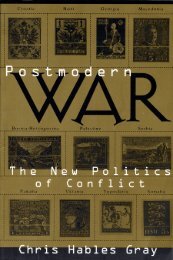6. Modern War - Chris Hables Gray
6. Modern War - Chris Hables Gray
6. Modern War - Chris Hables Gray
Create successful ePaper yourself
Turn your PDF publications into a flip-book with our unique Google optimized e-Paper software.
<strong>Modern</strong> <strong>War</strong> [ 113 ]<br />
was nurtured by many forces, among the most important are the ones Hall<br />
emphasizes. In turn, science changed the crafts, the bureaucracies, and<br />
logistics. Besides the general matrix these social forces shared, the men of the<br />
new philosophy, now known as science, made many direct contributions to<br />
the changes in war that marked the birth of the modern age. Hall himself<br />
points out many specific instances. For example, navigation and artillery<br />
were strongly improved by scientific discoveries and approaches (Hall, 1969,<br />
pp. 5-6), and both the Royal Society and the Academie des Sciences were<br />
interested in ways of testing gunpowder (p. 10). In terms of fortifications,<br />
geometry was crucial. Bonaiuto Lorini said it was "essential, the very foundation<br />
of all our procedures" (quoted on p. 12).<br />
Perhaps the clearest case in this period of science influencing war is<br />
artillery. All the authoritative artillerists of the time claimed science was<br />
necessary for artillery, and all used mathematical tables, even though they<br />
were not empirically developed but based on various theories of ballistics that<br />
have since been discredited, such as proportional symmetry and strictly<br />
rectilinear segments. Galileo produced the first correct tables in his Discourses<br />
on Two New Sciences, in 1638. "This work on ballistics was developed further<br />
by Galileo s pupil, Evangelista Torricelli, who generalized and completed the<br />
theory, after which it passed into general circulation" (pp. 20-21).<br />
Wolf makes a similar point when he notes the improvements of<br />
cannon and mortars in the period 1670-1789 in terms of standardizing<br />
balls, reducing the charge of powder, better caissons, new types of<br />
harness, and better servicing equipment and procedures. All of these<br />
innovations were brought about by engineers and bureaucrats working<br />
for navy and war ministries. He also comments: "Perhaps of equal<br />
importance was the development of more effective weapons in the hands<br />
of the seventeenth century infantryman. By 1500-1550 firearms had<br />
completely displaced the cross- and longbows" (pp. 35-36). Over the<br />
next two hundred years there were many other improvements, including<br />
the fusil or flintlock, strap bayonets, better cartridges, and iron ramrods.<br />
These Wolf attributes to gunsmiths and sportsmen, not scientists. 4<br />
John Nef, on the other hand, argues clearly that "behind the development<br />
of artillery and small firearms at the end of the fifteenth century was<br />
[the] movement of scientific inquiry" (1963, p. 44). He also emphasizes that<br />
some of the earliest scientists were military men, who made their discoveries<br />
in battle. The leading engineer of his day, Pedro Navarro, who invented<br />
explosive mines and floating batteries, is a case in point. Nef concludes that<br />
The instruments for inflicting pain and destruction were not prepared in<br />
laboratories as in our mechanical age; they were often improved with the<br />
enemy before the inventor's eyes; the mingled physical horror and perverse<br />
pleasure entailed in their use was more obvious, (p. 44)








